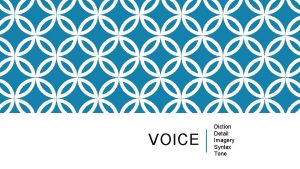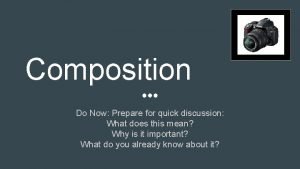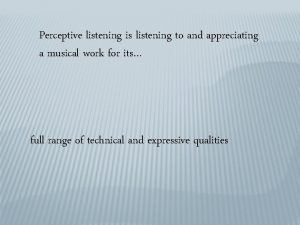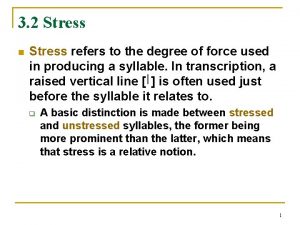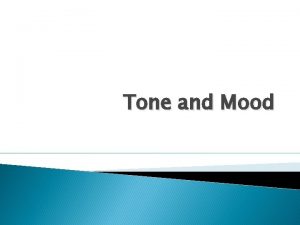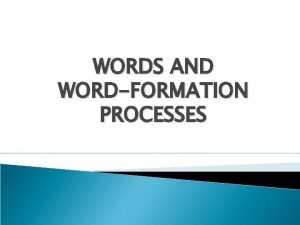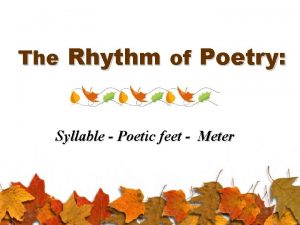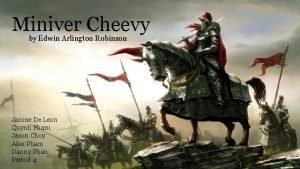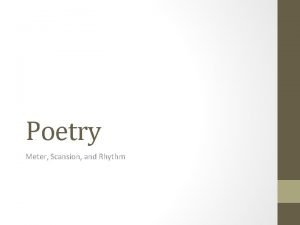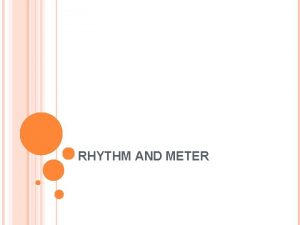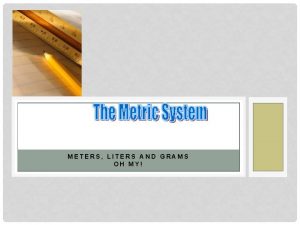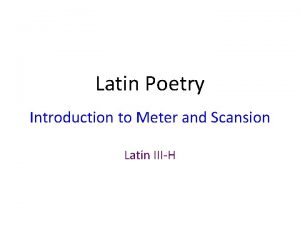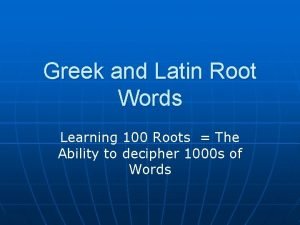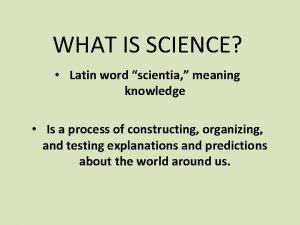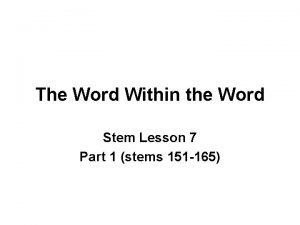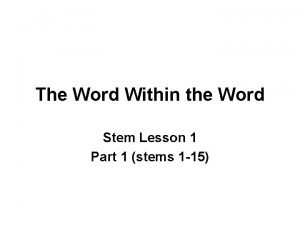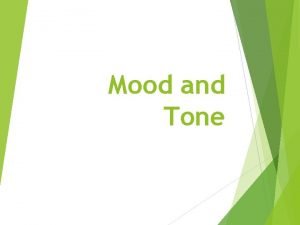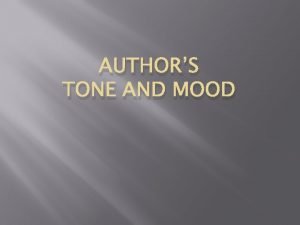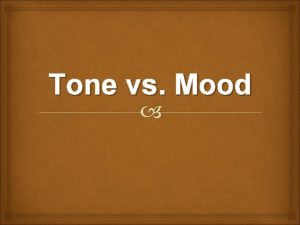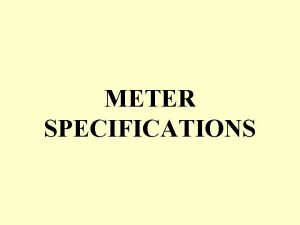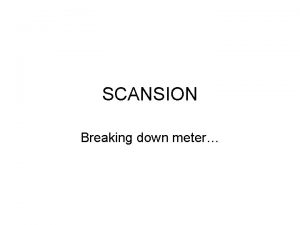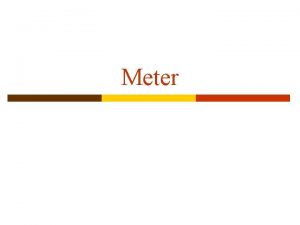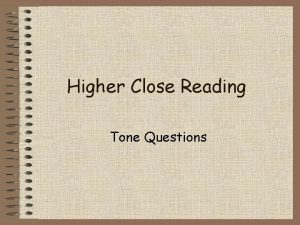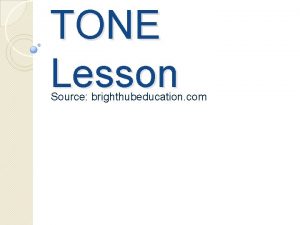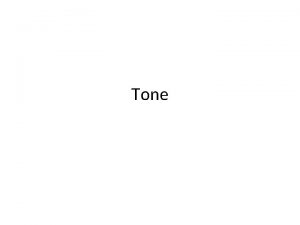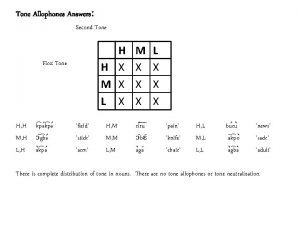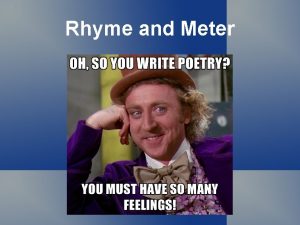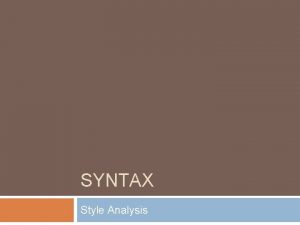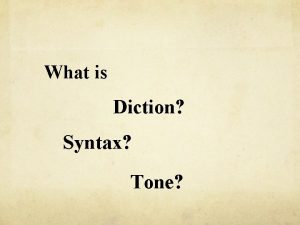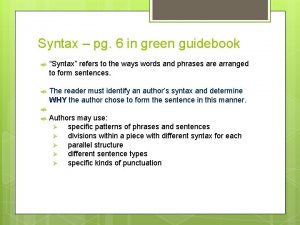Syntax Meter and Tone Syntax refers to word































- Slides: 31

Syntax, Meter, and Tone

Syntax refers to word order and sentence structure.

Common Techniques for Manipulating Syntax: 1. Unusual or inverted word order – which words are emphasized? 2. Sentence length – short and choppy? flowing? 3. Punctuation – interruptions? 4. Perspective- the order in which information is presented;

“Untitled” by Peter Meinke Open the poem called “Untitled” on my Helpful Resources page and answer these questions: What is the subject of the first half of the poem? The second half? How does the syntax help convey meaning?

More Techniques for Manipulating Syntax: 5. Interruptions – created by punctuation, inversions, or sentence length; 6. Parallel structure – a form of repetition 7. Mimetic syntax: word order that imitates the action it describes

Example of Mimetic Syntax: Me Up At Does

Syntactic Deviation Me up at does out of the floor quietly Stare a poisoned mouse still who alive is asking What have i done that You wouldn’t have • Revise the poem so that it will be more grammatical. A poisoned mouse who, still alive, is asking 'What have I done that you wouldn't have? ' stares quietly up at me.

Syntactic Deviation Me up at does out of the floor quietly Stare a poisoned mouse still who alive is asking What have i done that You wouldn’t have • The disrupted grammar of the 1 st part = the disjointed, uncomfortable effect on the persona of the poem, who has found the dying mouse (which presumably, was poisoned). • The use of the personifying pronoun 'who' instead of 'that‘, and the fact that the mouse is presented as asking a rhetorical question of the persona equates the mouse and the persona).

Syntactic Deviation Me up at does out of the floor quietly Stare a poisoned mouse still who alive is asking What have i done that You wouldn’t have • The last three lines of the poem are not grammatically disrupted we can see the force of the mouse's rhetorical question straightforwardly, and thus sympathise with its viewpoint. • Present tense helps make the situation seem more dramatic and vivid.

Deviant Syntax Semantic deviation: phrase containing a word whose meaning violates the expectations created by the surrounding words: “a grief ago” (expect a temporal - time-related - noun); “in the room so loud to my own” (expect a spatial – space-related - adjective) - Dylan Thomas

Deviant Syntax Grammatical deviation: phrase containing a word whose grammatical class violates the expectations created by the surrounding words: “the little / lame balloonman / whistles far and wee” (an adjective instead of a spatial adverb) “Anyone lived in a pretty how town” (an interrogative indefinite pronoun instead of a declarative indefinite pronoun [“someone”]; an adverb instead of an adjective). - e. e. cummings

Morphological Deviation Involves adding affixes to words which they would not usually have, or removing their ‘usual’ affixes; Breaking words up into their constituent morphemes, or running several words together so they appear as one long word a billion brains may coax undeath from fancied fact and spaceful time (e. e. cummings 1960)

Consider Diction: Words used contrary to expectation: “a grief ago” “Anyone lived in a pretty how town”

When analyzing DICTION, consider such questions as: • Is the language concrete or abstract? • Are the words monosyllabic or polysyllabic? • Do the words have interesting connotations? • Is the diction formal or colloquial? • Is there any change in the level of diction in the passage? • What can the reader infer about the speaker or the speaker’s attitude from the word choice? • Is there a change in diction in the poem?

Consider Word Order : Normal English word order = subject-verb-object sequence or subject-verb-complement. Shifted word order serves to: create emphasis, heighten connections create implications Impact can be: emotional psychological spiritual

Ultimately: In many cases the poet will manipulate diction and syntax in unexpected or deviant ways. This is popularly called “poetic license, ” but poets don't bend the “rules” of language just because they can; in a good poem, there is always a reason for unusual uses of language. Look for the hidden relation or significance that compensates for the break in the reader's expectations.

An example from "Neck" by Sarah Arvio, recently published in The New Yorker: That isn’t done Grabbing your girlfriend’s neck isn’t done I mean it is done by god often enough but not when I’m the girl - omits natural, vocal pauses through enjambment. (“Enjambment “comes from the French word "to straddle" )

Now, Consider Other Poetic Devices: Figurative language and sound devices

In the English language, figures of speech can be classified into two types: schemes and tropes. Schemes deal with word order, letters, and sounds, and NOT meaning: The serpent slithered on the shifting sands. In addition to alliteration, some other examples of schemes include assonance, consonance, parallelism, asyndeton, and polysyndeton. Tropes are unexpected twists in the meanings of word: they include puns, hyperbole, irony, metaphor, oxymoron, metonymy, and synecdoche.

ALWAYS use an adjective when describing diction, syntax, and tone. “____ diction contributes to the ____ tone. ”

Finally, let’s talk about TONE: Tone is the narrator’s or speaker’s attitude toward the subject or subjects. A piece might have a tone that implies humor, sarcasm, loss, sadness, joy, acceptance, wonder, confusion, etc. It’s also important to note that a piece can embrace more than one tone. If you’re having trouble deciding the tone of a piece, look carefully at the placement of those words.

“Bouncing into the room, she lit up the vicinity with a joyous glow on her face as she told about her fiancé and their wedding plans. ” What are the specific words that create the feeling of the sentence? What words did the author use to create the feeling of the sentence?

“Bouncing into the room, she lit up the vicinity with a joyous glow on her face as she told about her fiancé and their wedding plans. ” Bouncing – lit – joyous – glow – fiancé - wedding What kind of words are these?

Bouncing into the room, she lit up the vicinity with a joyous glow on her face as she told about her fiancé and their wedding plans. ____ diction contributes to the ____ tone. Cheerful diction contributes to the euphoric tone. Or uplifting diction contributes to the joyful tone.

The manipulation of diction and syntax contribute to the tone: “My Papa’s Waltz” page 999 Consider: • What seems to be the speaker’s/narrator’s attitude in the piece? • Is more than one attitude or point of view expressed? • Does the piece have a noticeable emotional mood or atmosphere? • Can anything in the piece be described as irony?

“She huddled in the corner, clutching her tattered blanket and shaking convulsively, as she feverishly searched the room for the unknown dangers that awaited her. ” ____ diction contributes to the ____ tone. frightening diction contributes to the alarming tone.

“She lay on the couch in a white evening dress, whispering softly in the ear of her fiancé, running her fingers through his hair and gently nibbling his earlobe. ” ____ diction contributes to the ____ tone. suggestive diction contributes to the seductive tone.

“Harvard accepted her, allowing this child the opportunity to study in the same halls as the many famous scholars before her, giving her the chance to excel in her field in the best college in the United States. ” ____ diction contributes to the ____ tone. lofty diction contributes to the elevated tone.

Abhorrent abrupt accusing accusatory admonitory bantering bitter boring brash bucolic calm cautious childish coarse cold colloquial concerned despairing desperate disdainful disgusted ecstatic effusive elated elegiac eloquent embittered erudite exuberant foreboding gloomy harsh haughty hopeful humble indignant inflammatory irreverent irritated ironic joking joyful light loving miserable melancholic nervousnostalgic optimistic outraged paranoid passionate patronizing pedantic peaceful pessimistic pitiful pleasant playful proud pompous pretentious questioning reflective reminiscent resigned romantic sad sanctimonious sarcastic sardonic scornful sentimental serene serious sharp shocked silly solemn somber soothing snobbish snooty sympathetictaunting turgid vexed vibrant whimsical angry anxious appreciativeapologetic arrogant audaciouscondemning dark condescending contemptuous dreamy mocking moralistic mournful persuasive piquant cynical compassionate confidant

See………… The more words you know, the more sophisticated your descriptions will be when you analyze authors’ writing.

And one last tip………. . Never, never, never say: “The author uses diction. . . ” Do you mean – the author chooses words? ? Focus on the DEVICE: The ______diction _____ (what kind? ) what? ) (does
 Syntax directed definition and syntax directed translation
Syntax directed definition and syntax directed translation Gambar tekanan zat
Gambar tekanan zat Diction/syntax
Diction/syntax Intination
Intination Me up at does
Me up at does The narrator details the blues of the landscape
The narrator details the blues of the landscape Voice lessons diction answer key
Voice lessons diction answer key Informal written
Informal written What is informal style
What is informal style Meter latin root meaning
Meter latin root meaning Anatomy of a bullet cartridge
Anatomy of a bullet cartridge In a work of art the word composition refers to
In a work of art the word composition refers to What should you do to develop perceptive listening skills?
What should you do to develop perceptive listening skills? The word stress refers to
The word stress refers to How to explain the tone of a story
How to explain the tone of a story Binary microprogram
Binary microprogram In the beginning was the word and the word became flesh
In the beginning was the word and the word became flesh Blackout compounding or blending
Blackout compounding or blending Iamb poetry
Iamb poetry Edwin arlington robinson miniver cheevy
Edwin arlington robinson miniver cheevy Iambic pentameter in romeo and juliet
Iambic pentameter in romeo and juliet Meter and scansion worksheet answers
Meter and scansion worksheet answers Rajeev bapat
Rajeev bapat Rhyme scheme meter
Rhyme scheme meter Meters liters and grams
Meters liters and grams Dactylic hexameter
Dactylic hexameter Poetic foot
Poetic foot Words with the root kinesis
Words with the root kinesis What does the latin word scientia mean
What does the latin word scientia mean Plasto stem words
Plasto stem words Word within the word stems
Word within the word stems Word within the word list 6
Word within the word list 6






